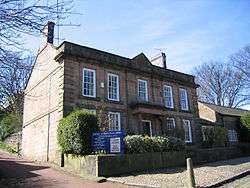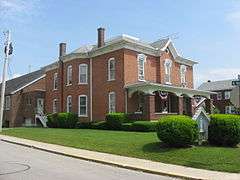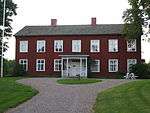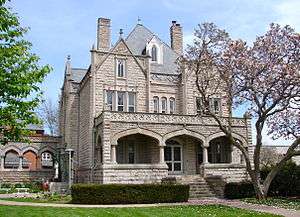Clergy house
A clergy house is the residence, or former residence, of one or more priests or ministers of religion.
Function
Clergy houses are typically owned and maintained by a church, as a benefit to its clergy. The practice exists in many denominations because of the tendency of clergy to be transferred from one church to another at relatively frequent intervals. Catholic clergy houses in particular may be lived in by several priests from a parish. Clergy houses frequently serve as the administrative office of the local parish as well as a residence; they are normally located next to, or at least close to, the church their occupant serves.
Partly because of the general conservationism of churches, many clergy houses are of historic interest or even importance. In the United Kingdom the 14th-century Alfriston Clergy House was the first property to be acquired by the National Trust. It was purchased in a state of near ruin in 1896 for £10, the vicarage having moved elsewhere long before.[1]
In some countries where the clergy houses were often rather grand they have now been sold off by the churches, exchanged for more modest properties. In England the "Old Vicarage" or "Old Rectory" is very common in villages, as a comfortable home for the upper middle-classes, and in Scotland the "Old Manse". Others are now offices or used for various functions.
Nomenclature
There are a number of more specific terms whose use depends on the rank of the occupant, the denomination and the locality. Above the parish level, traditionally a bishop's house was called a Bishop's Palace, a dean lives in a deanery, and a canon in a canonry or "canon's house". Other titles may have different names for their houses.
A rectory is the residence, or former residence, of an ecclesiastical rector, although also in some cases an academic rector (e.g. a Scottish university rector) or other person with that title. In North American Anglicanism a far greater proportion of parish clergy were and are titled rectors than in Britain, so the rectory is more common there. The names used for homes of the ordinary parish clergy vary considerably, and generalization is difficult:
- In the Anglican Communion vicarage or (more informal and old-fashioned) parsonage, and rectory if appropriate.
- Roman Catholics use priory, clergy house, parochial house (mostly Ireland), chapel house (in Scotland), and rectory if appropriate. In the Philippines, the term convent is used, a direct calque of the Spanish convento.
- Manse (cognate with mansion) is a Scottish term, used in Scottish Presbyterianism, and general in other parts of the British Isles by Non-conformist Churches such as the Methodists and the United Reformed Church. This word is also commonly used by Baptists in the United Kingdom[2] and some Commonwealth countries.[3]
- Pastorium is the usual term in the Southern United States, especially among Baptists.
- Lutheran churches often use parsonage.
- Parish house is used by many denominations
Gallery
- A rectory in Thuringia, Germany.
 Halton Vicarage, England; 1739 and still used.
Halton Vicarage, England; 1739 and still used. An 1887 Catholic rectory in Ohio
An 1887 Catholic rectory in Ohio

- Of 1923 rectory in Bączal Dolny, Poland.
 The rectory in Valö, Uppland, Sweden.
The rectory in Valö, Uppland, Sweden. Sacred Heart Cathedral Rectory in Davenport, Iowa, USA
Sacred Heart Cathedral Rectory in Davenport, Iowa, USA Old rectory of Deschambault (1815-1818), Canada
Old rectory of Deschambault (1815-1818), Canada
See also
References
| Wikimedia Commons has media related to Clergy residences. |
- ↑ Walker, Marianna (1 June 2008). "50 National Trust hidden gems". The Daily Telegraph. Retrieved 2010-07-07.
- ↑ "Manses and Church Houses". Baptist Union of Great Britain. Retrieved 13 September 2016.
- ↑ "North Adelaide Baptist Church - Manse". Adelaide City Council. Retrieved 13 September 2016.